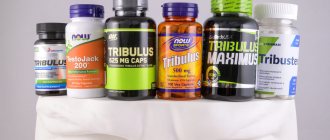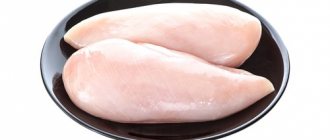Amino acids
Sergey Sidoruk 03/10/2019 no comments
1
Amino acids in bodybuilding - what are they and what are they needed for?
4.5 (90%) 2 votes
Amino acids are the basis for muscle growth; they are involved in the formation of protein compounds. Amino acids receive a lot of attention in bodybuilding due to the fact that protein is the main material for building muscles. The body especially needs them under heavy loads, most often during intense training. In case of amino acid deficiency, slow, and sometimes almost invisible, growth of muscle tissue occurs.
Why are amino acids needed?
Amino acids are substances that are the basis of protein molecules. Since protein is the main building material for the growth of muscle tissue, increased consumption of amino acids is important for athletes and people involved in fitness.
In addition to the “muscle-building” function, amino acids take part in:
- production of hormones, antibodies and digestive enzymes;
- growth of other body tissues;
- restoration and strengthening of the immune system.
Even the simplest physical exercises lead to increased consumption of these substances. And regular intense training causes the loss of up to 80% of the amino acids produced by the body. Such a deficiency not only reduces the effectiveness of the load, but is also harmful, as it can cause the destruction of muscle tissue.
The fact of the effectiveness of amino acids has a large evidence base. They are among the few sports supplements whose results have been proven by scientific research and are not the result of clever marketing.
Therefore, it is important to choose and learn how to drink amino acids correctly. They will help maintain muscle during dieting and cutting and, if necessary, can be used to accelerate the growth of all muscles in the body.
Products - sources of proteins
The human muscles and skeleton consist of living tissues that not only function but are also renewed throughout life. They recover from damage and retain their strength and durability. To do this, they require very specific nutrients. Food provides the body with the energy it needs for all processes, including muscle function, tissue growth and repair. And protein in the body is used both as a source of energy and as a building material.
Therefore, it is very important to observe its daily use in food. Protein-rich foods: chicken, turkey, lean ham, pork, beef, fish, shrimp, beans, lentils, bacon, eggs, nuts. All these products provide the body with protein and provide the energy necessary for life.
Contraindications and harm
Amino acids are the components of proteins that make up our muscles.
Articles regularly appear about the side effects of taking amino acids. But in the course of numerous studies, contraindications and possible harm were not established. Even if the specified dosage is exceeded many times, the side effect is minimal.
Keep in mind that the human body is able to absorb only 5-6 grams of amino acids within an hour. Regular intake of larger amounts may have a negative effect on kidney and liver function.
Popular classifications
The following types of amino acids are distinguished:
- aromatic;
- polar;
- non-polar;
- sulfur-containing;
- heterocyclic.
Athletes need amino acids to speed up metabolic processes and quickly gain muscle tissue
Amino acids for bodybuilders
These substances are widely used by athletes (bodybuilders) to improve metabolism and quickly gain muscle mass. Free acid amines and hydrolysates are used in the diet. The first group includes arginine, glutamine and glycine. Hydrolysates are simple proteins that are quickly absorbed by the body. Such connections are suitable for women and men. They are bought not at the pharmacy, but in specialized stores along with other dietary supplements.
For health and beauty
Amino acids are essential for more than just your brain and muscles. They are widely used in cosmetology. Acids have the following effects:
- help strengthen the skin by participating in the synthesis of collagen and elastin;
- smooth out wrinkles;
- prevent early aging;
- moisturize;
- strengthens hair and prevents hair loss.
Hair nourishers Solgar, NeocelL, Glow Matrix are widely used in cosmetology. The most effective products contain not only acids, but also beta-carotene, antioxidants, vitamins, provitamins and microelements (selenium, zinc).
Nonessential, essential and conditionally essential amino acids
Essential amino acids are distinguished by the fact that they are not formed in the human body and must be regularly supplied with food (fruits, meat, fish, dairy products, nuts, berries, herbs). The essential list includes phenylalanine, leucine, valine, 2,6-diaminohexanoic acid, arginine, threonine, methionine, isoleucine.
Partially replaced acids are formed in small quantities.
These include histidine and arginine. Conditionally replaceable acids are formed in the body only in the presence of non-replaceable ones. This group includes the amino acids cysteine and tyrosine. Replaceable acids (they are synthesized from other substances. The need for them from the outside is minimal.
Other types
Depending on the nature of catabolism (decomposition), natural acids are divided into:
- ketogenic (break down to form acetyl-coenzyme A, increase the concentration of ketone bodies in the blood);
- glycogenic (during breakdown, compounds are formed that can participate in the process of glucose formation);
- mixed (glyco-ketogenic).
You can replenish the supply of missing amino acids with pharmaceuticals
Types of amino acids and features of intake
So, you have decided that you need additional amino acids to increase the effectiveness of your workouts. Which ones do athletes take?
There are 20 types of amino acids in total. Nine of them are essential because the body receives them only from food and is not able to produce them on its own. They make up 35% of muscle tissue. Regularly gaining the required amount from food is only possible if you follow special high-protein diets, which is not always possible. Therefore, a special BCAA complex was created, which includes essential amino acids.
BCAA is usually a powdered mixture. The dosage is 4-8 grams for both weight loss and muscle gain. You need 2-3 doses a day - before training, after training and sometimes in the morning. A smaller dosage is not able to bring the desired results, since it cannot fully satisfy the body's needs. In general, the dosage depends on the intensity of the training load.
All other amino acids are nonessential. The body actively consumes them during exercise and also quickly absorbs them from food or additional complexes. They are available in the form of tablets, solutions, capsules and powder, which are equally effective. It is optimal to take them 5-10 g 3 times a day.
BCAAs and essential acids should be taken together. The duration of use is not limited. There is no need to take breaks or follow a cyclic regimen.
Plant and animal protein: which is better?
This is the formulation of the question that very often appears when discussing animal and vegetable protein, and it is fundamentally incorrect. There is no “bad” or “good” protein, they are different and the body needs both the first and the second in sufficient quantities. As mentioned above, all proteins have different amino acid composition. And we need ALL amino acids. Each of them performs its own function and, accordingly, the lack of any of them will sooner or later negatively affect the functioning of the body.
Some would say that complete proteins are more important because they contain essential amino acids. But if you eat only animal protein, a person will still experience a lack of those acids that they do not contain. In addition, the benefits of products are determined not only by the presence of amino acids. The ratio of proteins, “good” and “bad” fats and carbohydrates also plays a huge role. After all, if a product is rich in essential amino acids, but at the same time contains a lot of animal fats, its “usefulness” will significantly decrease even for those who do not watch their figure. Therefore, there is only one conclusion - the diet should be as varied as possible in order to fully cover the need for amino acids.
The amount of amino acids needed by a person involved in sports increases sharply. Accordingly, you need to either strictly control their intake from food, or take additional portions of amino acids in the form of sports nutrition supplements (for example, BCAAs).
But this does not mean that supplements are mandatory. It is quite possible to structure your diet in such a way as to cover all your amino acid needs. Sports nutrition has its benefits, but unless you are a competitive athlete, taking it is not absolutely necessary.
In the tables below you can find information about the main amino acids, their functions and sources. Among the products, only those in which each of the amino acids is found in more or less significant quantities are indicated.
Essential amino acids
| Amino acid | Functions | Sources |
| Valin |
|
|
| Isoleucine |
|
|
| Leucine |
|
|
| Lysine |
|
|
| Methionine |
|
|
| Threonine |
|
|
| Tryptophan |
|
|
| Phenylalanine |
|
|
Conditionally essential amino acids
| Amino acid | Functions | Sources |
| Tyrosine |
|
|
| Cysteine |
|
|
| Histidine |
|
|
Nonessential amino acids
| Amino acid | Functions | Sources |
| Arginine |
|
|
| Asparagine |
|
|
| Glutamine |
|
|
| Glutamic acid |
|
|
| Glycine |
|
|
| Carnitine (L-carnitine) |
|
|
| Ornithine (diaminovaleric acid) |
|
|
| Taurine |
|
|
Did you like the article? Say “thank you” to the author and share it on social networks by clicking on the corresponding icon in the lower right corner.
And to receive more useful information every day, subscribe to our Instagram.
Main types
Today there are two types of amino acid complexes - free amino acids and hydrolysates. The latter represent protein broken down to the required level. The advantages of hydrolysates (compared to protein) are the high rate of breakdown and delivery of useful substances to muscle fibers.
The product with free amino acids is almost the same and has the same qualities - high speed of absorption, effectiveness and purity. Thus, both products are needed in bodybuilding and can be beneficial.
Daily requirement: for whom and how much
Daily dosages are determined separately for each amino acid, based on the needs and characteristics of the body. Meanwhile, average values fluctuate between 0.5 and 2 g per day.
It is important to increase the level of consumption of amino acid complexes for people who are professionally involved in sports, as well as during intense physical activity, intense mental work, during and after illness. The correct balance of amino acids is important for children during growth.
The daily norms of the amino acid complex for bodybuilders range from 5 to 20 g of the substance for a single dose. Meanwhile, when combining the intake of these beneficial substances with sports nutrition, it is important to know some rules. The effectiveness of amino acids (the rate of absorption) is significantly reduced if they are consumed with food or food substitutes, proteins or gainers.
At the same time, people with genetic diseases (in which the absorption of amino acids is impaired) should not exceed the recommended daily doses. Otherwise, protein foods can cause changes in the functioning of the gastrointestinal tract and allergies. In addition, diabetics, people with liver disease, or those deficient in certain enzymes are at risk of developing amino acid imbalances.
When consuming protein foods, you should remember that amino acids are absorbed most quickly from egg whites, fish, cottage cheese and lean meat. And for more intensive absorption of nutrients, nutritionists advise combining foods correctly. Milk, for example, goes well with white bread or buckwheat, and proteins from cottage cheese or meat are paired with flour products.
Bodymaster.ru recommends Fitness Trainers:
Still wondering whether to take amino acid complexes or not? Stop procrastinating, it's time to act! Gone are the days when sports nutrition was an unaffordable luxury; today everyone can afford quality supplements. Plus, amino acids have no side effects, meaning you can experience all the benefits of these specially created supplements without fear of consequences. Whether you want to achieve relief, or are still at the stage of gaining mass through bodybuilding training, amino acids will become the very building material from which you will create impressive muscles. Give your body the opportunity to be perfect!
Bodymaster.ru recommends Training Plans:
Amino acids go well with different types of sports nutrition, but you can’t always take them at the same time and mix them. You cannot take amino acid complexes with protein, gainer, meal replacement or food, otherwise their absorption will take a very long time, which means the intake will become ineffective. Always read the manufacturer's instructions.
A logical question arises: is everything really so smooth and don’t such super-healthy supplements have side effects? Surprisingly, they really don’t exist, because amino acids are natural components of food, and the duration of their intake is not limited in any way - you can drink them without even taking breaks, unlike, for example, L-carnitine.
Essential amino acids. Contents in products
Essential amino acids can be obtained by the body only from food or supplements. Their functions are simply irreplaceable in the formation of healthy joints, beautiful hair, and strong muscles. What foods contain this type of amino acid? The list is given below:
• phenylalanine – dairy products, meat, sprouted wheat, oats;
• threonine – dairy products, eggs, meat;
• lysine – legumes, fish, poultry, sprouted wheat, dairy products, peanuts;
• valine – grains, mushrooms, dairy products, meat;
• methionine – peanuts, vegetables, legumes, lean meat, cottage cheese;
• tryptophan – nuts, dairy products, turkey meat, seeds, eggs;
• leucine – dairy products, meat, oats, sprouted wheat;
• isoleucine – poultry, cheese, fish, sprouted wheat, seeds, nuts;
• histidine – sprouted wheat, dairy products, meat.
Daily norm
The need for various substances, including amino acids, in our body depends on several factors:
- age;
- gender;
- level of physical and mental stress;
- health conditions and other things.
Daily requirement of essential amino acids. Photo: takzdorovo-ru.livejournal.com
Consider the daily requirement for essential amino acids for an adult weighing approximately 60 kilograms:
- tryptophan – 1 g;
- leucine – 5 g;
- threonine – 2.5 g;
- valine – 3.5 g;
- lysine – 4 g;
- isoleucine – 3.5 g;
- methionine – 3 g;
- phenylalanine – 3 g.
Histidine and arginine are also necessary for children; they are not able to be synthesized in babies, so they must be supplied with food. In the future, their liver will be able to create these essential amino acids from non-essential ones.
 These include histidine and arginine. Conditionally replaceable acids are formed in the body only in the presence of non-replaceable ones. This group includes the amino acids cysteine and tyrosine. Replaceable acids (they are synthesized from other substances. The need for them from the outside is minimal.
These include histidine and arginine. Conditionally replaceable acids are formed in the body only in the presence of non-replaceable ones. This group includes the amino acids cysteine and tyrosine. Replaceable acids (they are synthesized from other substances. The need for them from the outside is minimal. 










